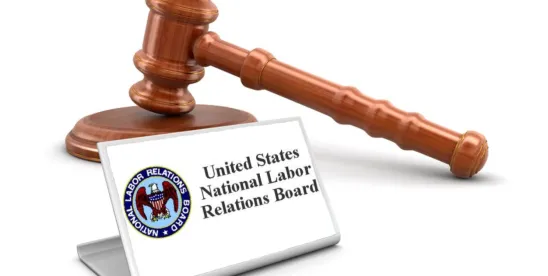On August 19, 2025, the U.S. Court of Appeals for the Fifth Circuit affirmed the issuance of preliminary injunctions by district courts that halted National Labor Relations Board (NLRB) unfair labor practice (ULP) proceedings against three employers, ruling that the structure of the NLRB was likely unconstitutional. The decision keeps the injunctions in effect while the employers continue to pursue their arguments that the NLRB is unconstitutional.
Quick Hits
- The Fifth Circuit held that the statutory limits on the president’s power to remove board members and ALJs were likely unconstitutional and violative of the U.S. Constitution’s separation-of-powers doctrine.
- The decision maintains the injunctions that had enjoined ULP proceedings involving the three employers at issue, allowing the employers to continue to challenge the NLRB’s constitutionality.
- The decision addresses only the propriety of the injunctions’ issuance. The ultimate question of whether the NLRB’s structure is constitutional will very likely be decided by the Supreme Court of the United States.
- The Fifth did not address the potential remedy if the NLRB’s structure was unconstitutional. It did, however, suggest that the constitutional problem might be solved by “severing” the limits on presidential removal and leaving the remainder of the statute intact.
Removal Protections Likely Unconstitutional
The decision notes that the statutory limits on removing administrative law judges (ALJs) are likely unconstitutional, as “ALJs are inferior officers insulated by two layers of for-cause removal protection.” Thus, ALJs may be removed only for good cause as determined by the U.S. Merit Systems Protection Board (MSPB), whose members themselves are removable only for cause. Such a dual-layer of for-cause removal protection is unconstitutional, the panel wrote.
Further, while acknowledging that the constitutionality of removal protections for NLRB members was a “closer call,” the three-judge appellate panel found that the for-cause protections enjoyed by NLRB members also likely violated the Constitution. Under the National Labor Relations Act (NLRA), the president may remove NLRB members “for neglect of duty or malfeasance in office, but for no other cause.”
In particular, the panel rejected the argument that such a restriction was constitutional under the Supreme Court’s 1935 decision in Humphrey’s Executor v. United States, which upheld restrictions on the president’s authority to remove officers of certain types of independent agencies—in that case, a commissioner of the Federal Trade Commission (FTC).
The panel noted that courts “have been reluctant to extend” that decision to agencies that are “not a ‘mirror image’” of the FTC. Instead, the panel found that the Humphrey’s Executor decision represented a “narrow exception, limited to ‘multimember expert agencies that do not wield substantial executive power.’” Unlike FTC commissioners in 1935, NLRB members do wield substantial executive power, as they “determine bargaining units, direct representation elections, adjudicate unfair-labor-practice charges, and seek enforcement of their orders in federal court,” the panel stated.
Additionally, the panel pointed to the Supreme Court’s recent stay of lower court orders that would have reinstated former NLRB Member Gwynne Wilcox and MPSB Member Cathy Harris to their respective boards while they challenged their removals by President Trump earlier this year.
Propriety of Injunctive Relief
The NLRB had argued that the challengers would not suffer immediate and irreparable harm, a showing that is typically required for injunctive relief, if the removal protections were ultimately found to be unconstitutional. The NLRB had argued that no actual harm would result from limitations on removal, and that, in any event, any arguable harm could be remedied on appeal from an ALJ or Board decision. A majority of the Fifth Circuit panel rejected these arguments out of hand, noting, “The Employers have made their case and should not have to choose between compliance and constitutionality. When an agency’s structure violates the separation of powers, the harm is immediate—and the remedy must be, too.”
Next Steps
The Fifth Circuit Court of Appeals’ ruling applies within the Fifth Circuit, a jurisdiction covering federal districts in the states of Louisiana, Mississippi, and Texas, and it likely means that employers in those states will be able to obtain injunctions blocking ULP litigation and potentially other NLRB proceedings by filing similar constitutional challenges.
More broadly, the ruling is another piece in the ongoing battle over the constitutionality of the NLRB and other independent federal agencies and the continuing viability of the “administrative state.” The constitutionality of the NLRB’s structure will very likely be decided by the Supreme Court, perhaps as early as its next term. While it is always difficult to predict how the Supreme Court will rule, its recent rulings may signal that the Court is prepared to hold that removal protections for NLRB members violate the separation of powers of the U.S. Constitution.
Of greatest practical consequence, though, is what will happen if the Court ultimately holds that the statutory removal restrictions are unconstitutional. In such cases, the prevailing doctrine in federal law is to remove or “sever” the constitutional impediment and leave the remainder of the statute in place. Indeed, the NLRA itself appears to provide for precisely this type of approach since Section 16 of the Act provides, “If any provision of this Act [subchapter], or the application of such provision to any person or circumstances, shall be held invalid, the remainder of this Act [subchapter], or the application of such provision to persons or circumstances other than those as to which it is held invalid, shall not be affected thereby.”
Thus, the remedy to any constitutional defect in the NLRB’s structure would likely be merely “writing out” of the statute its removal limitations and making NLRB members and ALJs terminable at will by the president. That said, there is a more expansive argument that if the U.S. Congress deemed such removal protections, and the “independence” they guarantee, to be central or essential to the NLRA itself, the entire statute could fall. That bar, however, would be very high. In essence, it would require a finding that in the absence of the statutory removal protections, Congress never would have passed the NLRA in the first place. Unlikely as that might be, the unfolding constitutional debate demands attention.






 />i
/>i

